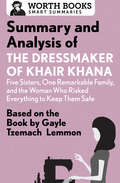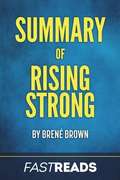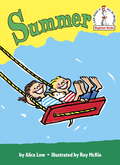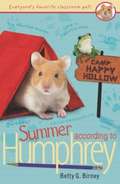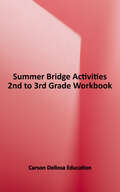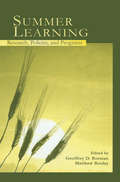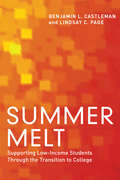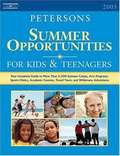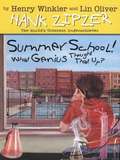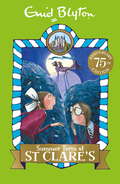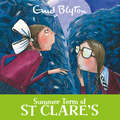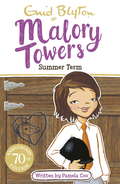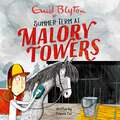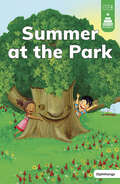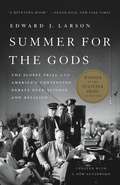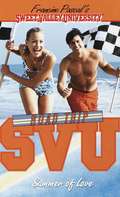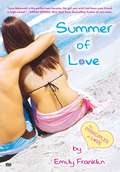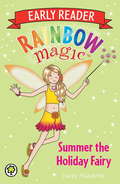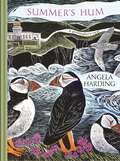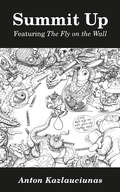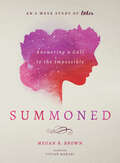- Table View
- List View
Summary and Analysis of the Dressmaker of Khair Khana: Based on the Book by Gayle Tzemach Lemmon
by Worth BooksSo much to read, so little time? This brief overview of The Dressmaker of Khair Khana tells you what you need to know—before or after you read Gayle Tzemach Lemmon’s book. Crafted and edited with care, Worth Books set the standard for quality and give you the tools you need to be a well-informed reader. This short summary and analysis of The Dressmaker of Khair Khana: Five Sisters, One Remarkable Family, and the Woman Who Risked Everything to Keep Them Safe includes: Historical contextChapter-by-chapter overviewsProfiles of the main charactersDetailed timeline of key eventsImportant quotesFascinating triviaGlossary of termsSupporting material to enhance your understanding of the original work About The Dressmaker of Khair Khana by Gayle Tzemach Lemmon: The Dressmaker of Khair Khana is the inspiring true story of Kamila Sidiqi, a young woman who received her teaching certificate the day the Taliban entered and occupied Kabul in 1990. With ingenuity, faith, and leadership, Kamila established a garment business in her living room—employing family members and neighbors—which enabled their survival in during one of the most tumultuous decades in the region. Gayle Tzemach Lemmon tells the uplifting story of the women who, with quiet heroism, not only survived Taliban rule, but supported and protected their families and fellow Afghans. The summary and analysis in this ebook are intended to complement your reading experience and bring you closer to a great work of nonfiction.
Summary of Rising Strong
by Brene Brown FastreadsDon't miss out on the fresh perspective of bestselling author and social scientist Brené Brown in this summary of her book, "Rising Strong: The Reckoning, The Rumble, The Revolution." This FastReads Summary contains full chapter synopses, key takeaways and analysis to help you quickly understand Brown's insight and turn your own vulnerability into strength today.
Summer (Beginner Books(R))
by Roy Mckie Alice LowA boy, a girl, and a dog share the joys of summer-swimming, fishing, gardening, watching fireworks, chasing butterflies, and toasting marshmallows-in this newly recolorized backlist classic.
Summer According to Humphrey (Humphrey #6)
by Betty G. BirneyThe sixth book in the beloved and award-winning school hamster series!When Humphrey hears that school is ending, he can't believe his ears. What's a classroom hamster to do if there's no more school? It turns out that Mrs. Brisbane has planned something thrilling for Humphrey and Og the frog: they're going to Camp Happy Hollow with Ms. Mac and lots of the kids from Room 26! Camp is full of FUN-FUN-FUN new experiences, but it's also a little scary. There are fur-raising wild sounds and smells, and there's something called the Howler to watch out for. Humphrey is always curious about new adventures, but could camp be too wild even for him?Look for all twelve of Humphrey's adventures!
Summer Bridge Activities®, Grades 2 To 3 (Summer Bridge Activities Ser. #4)
by Carson Dellosa EducationAward-Winning Workbook: Summer Bridge Activities is the recipient of the 2018 Kids' Product of the Year Award and Travel Fun of the Year Award from "Creative Child Magazine." This workbook was designed to prevent summer learning loss and help your child get a headstart on the next year. Includes: One Summer Bridge Activities workbook for 2nd to 3rd grade. This workbook focuses on math, writing, reading, science, social studies, fitness, and character building. It also includes bonus stickers and flash cards. 15 Minutes A Day: These best-selling summer activity books are designed to prevent learning loss in just 15 minutes per day. Each page is numbered by day so children and parents can track progress and reach monthly learning goals. Teacher-Recommended: Summer Bridge is a teacher-recommended workbook that parents have loved and trusted for the last 10 years. Summer Bridge Activities is available for preschool through 8th grade. Support your children through the end of middle school! Summer Learning Loss: Summer learning loss is when children lose skills learned in school over the course of the summer season. Two months of learning loss occurs during the summer, with the highest losses being in math and spelling.
Summer Learning: Research, Policies, and Programs
by Geoffrey D. Borman Matthew BoulayThis book brings together up-to-date, research-based evidence concerning summer learning and provides descriptions and analyses of a range of summer school programs. The chapters present theory and data that explain both the phenomenon of summer learning loss and the potential for effective summer programs to mitigate loss and increase student achievement.Summer Learning: Research, Policies, and Programs:*presents evidence describing variations in summer learning loss and how these learning differences affect equality of educational opportunity and outcomes in the United States;*discusses the development, characteristics, and effects of the most recent wave of summer programs which are designed to play key roles in the recent standards movement and related efforts to end social promotion;*examines the impact of three of the most widespread, replicable summer school programs serving students across the United States; and*considers the characteristics and effects of alternative programs and practices that are designed to combat the problem of summer learning loss head on.Intended for education researchers, practitioners, policymakers, and graduate students, this volume is particularly relevant to those interested in social stratification, equity-minded policies, implications of the current standards movement and high stakes testing, and the development of programs and practices for improving education.
Summer Melt: Supporting Low-Income Students Through the Transition to College
by Benjamin L. Castleman Lindsay C. PageUnder increasing pressure to raise graduation rates and ensure that students leave high school college- and career-ready, many school and district leaders may believe that, when students graduate with college acceptances in hand, their work is done. But as Benjamin L. Castleman and Lindsay C. Page show, summer can be a time of significant attrition among college-intending seniors—especially those from low-income families. Anywhere from 10 to 40 percent of students presumed to be headed to college fail to matriculate at any postsecondary institution in the fall following high school.Summer Melt explores the complex factors that contribute to this trend—the absence of school support, confusion over paperwork, lack of parental guidance, and the teenage tendency to procrastinate. The authors draw on findings from fields such as neuroscience, behavioral economics, and social psychology to contextualize these factors. Drawing on a series of research studies, they show how schools and districts can develop effective, low-cost, scalable responses—including counselor outreach, peer mentoring, and using text messages and social media—to help students stay on track over the summer.Summer Melt offers very practical guidance for schools and districts committed to helping their students make the transition to college.
Summer Opportunities for Kids and Teenagers 2005
by Peterson'sEnvironmental awareness camps in Costa Rica? College-prep courses on some of America's most prestigious campuses? They're all here, and much more.
Summer School! What Genius Thought That Up? (Hank Zipzer, the World's Greatest Underachiever #8)
by Henry Winkler Lin Oliver Tim HeitzSummer school are two words in the English language that Hank Zipzer doesn't want to learn. But there's no getting out of this one for Hank-summer school, here he comes! <p> <p>Will Hank have to spend the summer bored to death inside a sweltering classroom, or will he actually learn a cool lesson or two? <p><b> Lexile Level: 760L</b></p>
Summer Term at St Clare's: Book 3 (St Clare's #3)
by Enid BlytonSchooldays at St Clare's are never dull for twins Pat and Isabel O'Sullivan in Enid Blyton's much-loved boarding school series.In book three, Pat and Isabel look forward to their first summer term at St Clare's. They soon make friends with new girl Carlotta, who has a secret past that she's desperate to hide. But sneaky Prudence finds out and tells everybody. How will the class react?There'll be mischief at St Clare's!Between 1941 and 1946, Enid Blyton wrote six novels set at St Clare's. This edition features the original text and is unillustrated.
Summer Term at St Clare's: Book 3 (St Clare's #3)
by Enid BlytonSchooldays at St Clare's are never dull for twins Pat and Isabel O'Sullivan in Enid Blyton's much-loved boarding school series.In book three, Pat and Isabel look forward to their first summer term at St Clare's. They soon make friends with new girl Carlotta, who has a secret past that she's desperate to hide. But sneaky Prudence finds out and tells everybody. How will the class react?There'll be mischief at St Clare's!(P) 2017 Hodder Children's Books
Summer Term: Book 8
by Enid BlytonWelcome to Malory Towers, where there's more to life than lessons!Summer at Malory Towers means picnics, swimming and horse-riding. There are also the usual tricks to play and secrets to keep, but no one was expecting a mystery to solve. So when a horse is stolen from the riding school run by old girls Bill and Clarissa, all the third-formers want to help. Who could the culprit be?Between 1946 and 1951, Enid Blyton wrote six novels set at Malory Towers. Books 7-12 are authorised sequels of the series written by Pamela Cox in 2009 and focus on the adventures of Felicity Rivers, Susan Blake, and June Johns. This edition is unillustrated.Malory Towers is now a fantastic television drama, available on BBC iPlayer and on CBBC.*Malory Towers ®, Enid Blyton ® and Enid Blyton's signature are registered trade marks of Hodder & Stoughton Limited. No trade mark or copyrighted material may be reproduced without the express written permission of the trade mark and copyright owner.
Summer Term: Book 8 (Malory Towers #38)
by Enid BlytonWelcome to Malory Towers, where there's more to life than lessons!Summer at Malory Towers means picnics, swimming and horse-riding. There are also the usual tricks to play and secrets to keep, but no one was expecting a mystery to solve. So when a horse is stolen from the riding school run by old girls Bill and Clarissa, all the third-formers want to help. Who could the culprit be?Between 1946 and 1951, Enid Blyton wrote six novels set at Malory Towers. Books 7-12 are authorised sequels of the series written by Pamela Cox in 2009 and focus on the adventures of Felicity Rivers, Susan Blake, and June Johns. This edition is unillustrated.Malory Towers is now a fantastic television drama, available on BBC iPlayer and on CBBC.*Malory Towers ®, Enid Blyton ® and Enid Blyton's signature are registered trade marks of Hodder & Stoughton Limited. No trade mark or copyrighted material may be reproduced without the express written permission of the trade mark and copyright owner.
Summer Term: Book 8 (Malory Towers #8)
by Enid BlytonWelcome to Malory Towers, where there's more to life than lessons!Summer at Malory Towers means picnics, swimming and horse-riding. There are also the usual tricks to play and secrets to keep, but no one was expecting a mystery to solve. So when a horse is stolen from the riding school run by old girls Bill and Clarissa, all the third-formers want to help. Who could the culprit be? Between 1946 and 1951, Enid Blyton wrote six novels set at Malory Towers. Books 7-12 are authorised sequels of the series written by Pamela Cox in 2009 and focus on the adventures of Felicity Rivers, Susan Blake, and June Johns. This edition is unillustrated.(P) 2019 Hodder & Stoughton Limited Malory Towers ®, Enid Blyton ® and Enid Blyton's signature are registered trade marks of Hodder & Stoughton Limited. No trade mark or copyrighted material may be reproduced without the express written permission of the trade mark and copyright owner.
Summer at the Park (Stairway Decodables Step 6)
by Leanna KochLeela and Reed are eager to enjoy a summer day at the park. From playing on the new playground to meeting a robin, they have a fun time in the sun. When they are hot and tired, their favorite oak tree greets them with a shady spot to escape the heat. Stairway Decodables is a supplemental phonics resource that’s perfect for supporting small group instruction, independent reading, or reading practice at home. This title provides practice in decoding words with the diphthong ou/ow.
Summer for the Gods: The Scopes Trial and America's Continuing Debate Over Science and Religion
by Edward J. LarsonThe Pulitzer Prize-winning history of the Scopes Trial and the battle over evolution and creation in America's schools.In the summer of 1925, the sleepy hamlet of Dayton, Tennessee, became the setting for one of the twentieth century's most contentious courtroom dramas, pitting William Jennings Bryan and the anti-Darwinists against a teacher named John Scopes, represented by Clarence Darrow and the ACLU, in a famous debate over science, religion, and their place in public education. That trial marked the start of a battle that continues to this day in cities and states throughout the country. Edward Larson's classic Summer for the Gods -- winner of the Pulitzer Prize in History -- is the single most authoritative account of this pivotal event. An afterword assesses the state of the battle between creationism and evolution, and points the way to how it might potentially be resolved.
Summer of Love (Sweet Valley University #50)
by Francine Pascal Laurie JohnThe end of the road... A $5,000 scholarship is just a mission away, but Elizabeth Wakefield would rather win Sam Burgess's love. Impossible--since Sam's girlfriend is waiting for him at the finish line. Well, Elizabeth hasn't come this far for nothing. She's going to show Sam how strong she really is... even if it kills her. The final straw? Jessica Wakefield has had it! Her team does nothing but argue, she hasn't hooked up with anyone, and her final mission involves facing one of her biggest fears. Will she abandon her team at the last minute? Tom Watts and Todd Wilkins--best buddies? Absolutely! Angered by Sam's treatment of Elizabeth, they're ready to fight for her--unless they wind up fighting over her instead!
Summer of Love: The Principles of Love
by Emily FranklinAfter a rough spring semester at Hadley Hall, Love Bukowski is ready for some sun on Martha's Vineyard. Running her Aunt Mable's cafe might not sound glamorous, but when she's working with her best friend, Arabella, anything can be fun. Plus, Mable's set up a treasure map of clues for her to find--each one bringing Love closer to the truth about her family history. But now that those pieces of her past are finally fitting together, Love's future isn't clear. College and senior year are ahead, but the boys of summer are more appealing than ever. Surprises, sun, summer love--no matter what happens, the next three months will be ones to write home about.
Summer the Holiday Fairy (Rainbow Magic Early Reader #5)
by Daisy MeadowsThese cheerful and inviting Early Readers bring the blast of colour that Rainbow Magic's youngest fans have been waiting for!Rachel and Kirsty are on a trip to Rainspell Island. But Jack Frost has taken the three magical shells that make all holidays full of fun and sun! Can the girls help Summer the Holiday Fairy get them back before the Ice Lord ruins all holidays?'These stories are magic; they turn children into readers!' ReadingZone.comIf you like Rainbow Magic, check out Daisy Meadows' other series: Magic Animal Friends and Unicorn Magic!
Summer's Hum: part of a beautiful new series from beloved illustrator and print-maker Angela Harding
by Angela Harding'The wildflower bank outside my window hums and buzzes. At midday, the summer sun spreads the perfume of roses and honeysuckle to every corner.'Summer's Hum is the second book in a stunning seasonal quartet from beloved printmaker and illustrator Angela Harding. Each title in this pocket-sized series takes readers on a journey through the seasons, reflecting Angela's observations as the nature around her transforms and evolves over the course of a year. Taking in landscapes across the UK including views from her home studio in Rutland, to the Scottish wilderness, via the low-lying marshlands of Suffolk and the windswept hills of Yorkshire, the beautiful illustrations and evocative imagery of the prose make this the perfect book for nature lovers and art lovers everywhere.Featuring over thirty of Angela Harding's favourite prints alongside observations taken from her books A Year Unfolding, Wild Light and Still Waters & Wild Waves, each short, small book in this seasonal collection is a beautiful new way to enjoy Angela's work and celebrate nature and wildlife across the UK at all times of year.Collect all four titles: Spring Unfurled, Summer's Hum, Falling into Autumn, Winter's Song.
Summer's Hum: part of a beautiful new series from beloved illustrator and print-maker Angela Harding
by Angela Harding'The wildflower bank outside my window hums and buzzes. At midday, the summer sun spreads the perfume of roses and honeysuckle to every corner.'Summer's Hum is the second book in a stunning seasonal quartet from beloved printmaker and illustrator Angela Harding. Each title in this pocket-sized series takes readers on a journey through the seasons, reflecting Angela's observations as the nature around her transforms and evolves over the course of a year. Taking in landscapes across the UK including views from her home studio in Rutland, to the Scottish wilderness, via the low-lying marshlands of Suffolk and the windswept hills of Yorkshire, the beautiful illustrations and evocative imagery of the prose make this the perfect book for nature lovers and art lovers everywhere.Featuring over thirty of Angela Harding's favourite prints alongside observations taken from her books A Year Unfolding, Wild Light and Still Waters & Wild Waves, each short, small book in this seasonal collection is a beautiful new way to enjoy Angela's work and celebrate nature and wildlife across the UK at all times of year.Collect all four titles: Spring Unfurled, Summer's Hum, Falling into Autumn, Winter's Song.
Summerhill: A Radical Approach to Child Rearing
by A. S. NeillThe world's greatest experiment in bestowing unstinted love and approval on children, by applying the principles of freedom and non-repression.
Summit Up
by Anton KazlauciunasThe more we look, the more we see. The more we see, the more we understand. With our eyes we see, we ruminate, speculate, compare, compose, even cogitate a little, animadvert perhaps, create balance, empathy, order out of chaos, understanding rises from conflict, beauty out of the undefined, trust replaces prejudice and suspicion, light emerges from the darkness, love out of hate, peace from war. We create hopes of dreams, belief out of impossibility, reality materializes from imagination. And so artists draw. Please read the pictures and think for yourselves.
Summoned: Answering a Call to the Impossible: An 8-Week Study of Esther
by Megan B. BrownEncounter the fullness of God&’s grace, the power of His promises, and the beauty of His faithfulness—all through the life of one woman: Esther.In a time when the world around her seemed to crumble, a young Hebrew girl found herself in a unique position to help save her people—and to encounter the greatness of our ever-faithful God. In Summoned, you&’ll enter the story of Esther—her calling, pain, and role in God&’s ultimate plan for salvation—and see how God is always working in the lives of His people, even when He seems distant. Through this 8-week, interactive study, you&’ll develop a deeper appreciation for God&’s Word and begin to see that stepping out in faith for His glory is often the first step to encountering His redeeming love.
Summoned: Answering a Call to the Impossible: An 8-Week Study of Esther
by Megan B. BrownEncounter the fullness of God&’s grace, the power of His promises, and the beauty of His faithfulness—all through the life of one woman: Esther.In a time when the world around her seemed to crumble, a young Hebrew girl found herself in a unique position to help save her people—and to encounter the greatness of our ever-faithful God. In Summoned, you&’ll enter the story of Esther—her calling, pain, and role in God&’s ultimate plan for salvation—and see how God is always working in the lives of His people, even when He seems distant. Through this 8-week, interactive study, you&’ll develop a deeper appreciation for God&’s Word and begin to see that stepping out in faith for His glory is often the first step to encountering His redeeming love.
